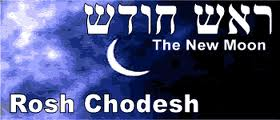Rosh Hodesh
 Rosh Hodesh marks the beginning of each new month of the Hebrew calendar.
Rosh Hodesh marks the beginning of each new month of the Hebrew calendar.
Pre-COVID-19, at MelvilleJC, we do so by holding a special 6:30am Rosh Hodesh Shaharit service, led by the Rabbi and the Shaliah Tzibbur, followed by a “bagels and coffee” collation.
All members of the congregation and students in the Religious School are welcomed and encouraged to attend.
To sponsor a Rosh Hodesh breakfast, please contact Elissa Spiegel at espiegel@melvillejc.org
Until further notice, our Rosh Hodesh services will be via zoom, followed by a “virtual” breakfast.
For further information, please contact Rabbi Orrin Krublit at rabbi@melvillejc.org
Rosh Hodesh Services for 5782:
For the month of Heshvan–Wednesday, Oct 6, 2021 at 6:30 am
For the month of Kislev–Friday, Nov 5, 2021 at 6:30 am
For the month of Tevet–Saturday, Dec 4, 2021 at 10:00 am
For the month of Shevat–Monday, Jan 3, 2022 at 6:30 am
For the month of Adar I–Tuesday, February 1, 2022 at 6:30 am
For the month of Adar II– Thursday, March 3, 2022 at 6:30 am
For the month of Nisan–Saturday, April 2, 2022 at 10:00 am
For the month of Iyar–Sunday, May 1, 2022 at 9:15 am
For the month of Sivan–Tuesday, May 31, 2022 at 6:30 am
For the month of Tammuz–Wednesday, June 29, 2022 at 6:30 am
For the month of Av–Friday, July 29, 2022 at 6:30 am
For the month of Elul–Saturday, Aug 27, 2022 at 10:00 am
From Virtual Library, Rosh Hodesh is the monthly celebration of the New Moon, according to the Jewish calendar. The Jewish calendar follows lunar months, each with 29 or 30 days, although the year is solar. Some scholars believe that lunar months derive from ancient nomadic calendars and solar years are the invention of agricultural societies; the Jewish calendar combines the two. Many Jewish festivals are tied to the lunar cycle; for example Sukkot and Passover begin on the full moon, in the middle of the month. Since 12 lunar months do not add up to one complete solar year, additional “leap months” are intercalated into the calendar in seven years out of a 19-year cycle.
Long ago, the appearance of the new moon each month was attested by witnesses. Once their testimony was deemed credible, fires were set on the hilltops to announce the new month to neighboring communities who, in turn, passed the message along. This system proved both dangerous and cumbersome, and once Jews lived outside Eretz Yisrael, it was wholely inadequate.
The present Jewish calendar was introduced in the time of Hillel II (358/9 CE), at which time astronomical calculations replaced the practice of calling witnesses before the Sanhedrin. Since that time, it has been possible to calculate the Jewish calendar well into the future on the basis of scientific calculations.
Sometimes Rosh Hodesh is one day, but sometimes it is celebrated for two days. Months are based on the lunar cycle, of course. The amount of time required for the moon to make one complete revolution around the earth is determined by the conjunction of the earth, moon, and sun (i.e. they lie along a line). When this happens, it is the new moon. A complete revolution takes 29 days, 12 hours, 44 minutes, 3-1/2 seconds. Days in our calendar must begin at sundown, regardless of when the conjunction actually takes place. Hence it is necessary to either add or subtract a half a day from each calendar month. For this reason, Hebrew months alternate between 29 and 30 days in length, with the actually moment of the new moon falling in between. The 30-day month is called “malei” (full) and the 29-day month is called “chaser” (defective). In any given leap year, Nisan, Sivan, Av, Tishrei, Shevat and Adar I are malei; Iyar, Tammuz, Elul, Tevet, Adar, and Adar II are chaser. Cheshvan and Kislev are sometimes malei and sometimes chaser. When a month is 30 days in length, the following month Rosh Hodesh is celebrated for two days because the 30th day of the month past is counted as Rosh Hodesh and the first day of the subsequent month as the second day of Rosh Hodesh.
Rosh Hodesh has long been recognized as a women’s holiday. In the Talmud [tractate Megillah 22b], we read that women are exempt from work on Rosh Hodesh. Rashi, on commenting on this passage, delineates the activities from which they may refrain: spinning, weaving, and sewing, because these are the skills which women so enthusiastically contributed to the building of the Mishkan (Tabernacle). Why do women merit a special holiday once a month? In midrash Pirke DeRabbi Eliezer, chapter 45, we are told that in the incident of the Golden Calf, the women refused to relinquish their earrings to the men who were building the calf. As a reward, God gave them an extra holy day each month, free from work. It is customary to wear new clothing on Rosh Hodesh, in celebration of the day’s special character.
Rosh Hodesh is announced on the Shabbat prior with a special benediction recited during the Torah Service. Rosh Hodesh, itself, is celebrated with a partial Hallel, musaf (in remembrance of the extra sacrifice brought on Rosh Hodesh), and Ya’aleh V’yavo is added to the Amidah and Birkhat HaMazon. In addition, the Haftarah for Rosh Hodesh falling on Shabbat is from Isaiah 66, a passage which employs fertility imagery to describe God and Zion as life-bearers, providing nurturance to the people Israel; the passage further prophesies a special pilgrimage to Jerusalem on Rosh Hodesh in the future.